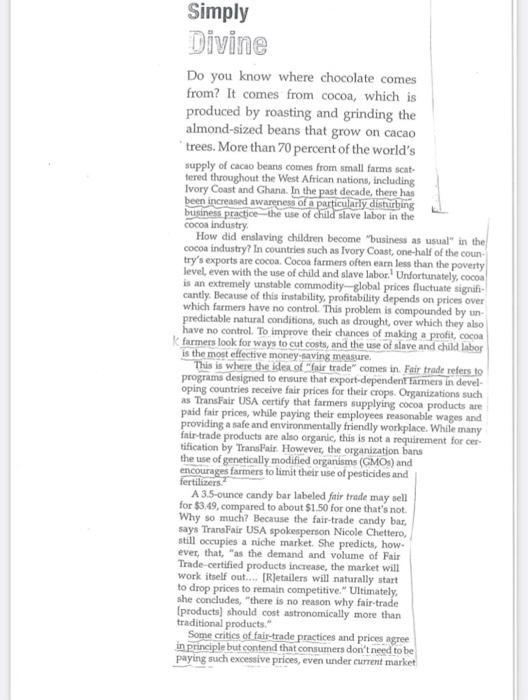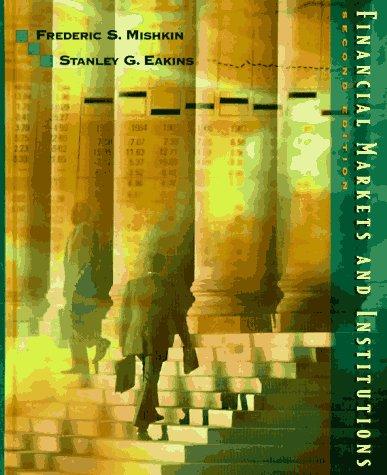Conclusion for this case study
this is what i was given only

Simply Divine Do you know where chocolate comes from? It comes from cocoa, which is produced by roasting and grinding the almond-sized beans that grow on cacao trees. More than 70 percent of the world's supply of cacao beans comes from small farms sent tered throughout the West African nations, including Ivory Coast and Ghana. In the past decade, there has been increased awareness of a particularly disturbing business practice the use of child slave labor in the cocoa industry How did enslaving children become "business as usual" in the cocoa industry? In countries such as Ivory Coast, one-half of the coun try's exports are cocoa Cocoa farmers often earn less than the poverty level, even with the use of child and slave labor. Unfortunately, cocoa is an extremely unstable commodity global prices fluctuate signifi- cantly. Because of this instability, profitability depends on prices over which farmers have no control. This problem is compounded by un predictable natural conditions, such as drought, over which they also have no control. To improve their chances of making a profit, cocoa K farmers look for ways to cut costs, and the use of slave and child labor is the most effective money-saving measure This is where the idea of "fair trade" comes in Fair trade refers to programs designed to ensure that export-dependent Farmers in devel- oping countries receive fair prices for their crops. Organizations such as TransFair USA certify that farmers supplying cocoa products are paid fair prion, while paying their employees reasonable wages and providing a safe and environmentally friendly workplace. While many fair trade products are also organic, this is not a requirement for cer tification by TransFair. However, the organization bans the use of genetically modified organisms (GMOs) and encourages farmers to limit their use of pesticides and fertilizers A 3.5-ounce candy bar labeled fair trade may sell for $3.49, compared to about $1.50 for one that's not. Why so much? Because the fair trade candy bat, says TransFair USA spokesperson Nicole Chettero, still occupies a niche market . She predicts, how- ever, that, as the demand and volume of Fair Trade certified products increase, the market will work itself out... [Retailers will naturally start to drop prices to remain competitive." Ultimately, she concludes, there is no reason why fair trade (products) should cost astronomically more than traditional products." Some critics of fair trade practices and prices agree in principle but contend that consumers don't need to be paying such excessive prices, even under current market Some critics of fair-trade practices and prices agree in principle but contend that consumers don't need to be paying such excessive prices, even under current market HY BUSINESS WORLD conditions. They point out that, according to TransFair's own data, cocoa farmers get only 3 cents of the $3.49 that a socially conscious con sumer pays for a Fair Trade-certified candy bar. "Farmers often receive very little," reports consumer researcher Lawrence Solomon. "Often fair trade is sold at a premium," he charges, "but the entire premium goes to the middlemen." Critics like Solomon suggest that sellers of fair trade products are taking advantage of consumers who are socially but not particularly price conscious. They point out that if sellers priced that $3.49 candy bar at $2.49, farmers would still be entitled to 3 cents. The price, they allege, is inflated to $3.49 simply because there's a small segment of the market willing pay it (while farmers still get only 3 cents). Fair- trade programs, advises English economist Tim Harford, "make a promise that the producers will get a good deal. They do not promise that the consumer will get a good deal. That's up to you as a savvy shopper.3 Divine Chocolate is a company that is taking fair trade cocoa to the next level. Unlike other companies selling fair trade chocolates, Divine returns a share of their profits to the farmers in their supply chain Divine's largest shareholder group is Kuapa Kokoo, a fair-trade cocoa cooperative not only receive Fairtrade price for their con huut also receive dividends from the HY BUSINESS WORLD conditions. They point out that, according to TransFair's own data, cocoa farmers get only y 3 cents of the $3.49 that a socially conscious con sumer pays for a Fair Trade-certified candy bar "Farmers often receive very little," reports consumer researcher Lawrence Solomon, "Often fair trade is sold at a premium," he charges, "but the entire premium goes to the middlemen." Critics like Solomon suggest that sellers of fair-trade products are taking advantage of consumers who are socially but not particularly price conscious. They point out that if sellers priced that $3.49 candy bar at $2.49, farmers would still be entitled to 3 cents. The price, they allege, is inflated to $3.49 simply because there's a small segment of the market willing pay it (while farmers still get only 3 cents). Fair- trade programs, advises English economist Tim Harford, "make a promise that the producers will get a good deal. They do not promise that the consumer will get a good deal. That's up to you as a savvy shopper. Divine Chocolate is a company that is taking fair trade cocoa to the next level. Unlike other companies selling fair trade chocolates, Divine returns a share of their profits to the farmers in their supply chain Divine's largest shareholder group is Kuapa Kokoo, a fair trade cocoa cooperative. Cocon farmers who belong to this group not only receive a fair trade price for their cocoa but also receive dividends from the profits of Divine Chocolate. (After studying the content in this chapter, you should be able to answer the set of discussion questions found at the end of the chapter.) Simply Divine Do you know where chocolate comes from? It comes from cocoa, which is produced by roasting and grinding the almond-sized beans that grow on cacao trees. More than 70 percent of the world's supply of cacao beans comes from small farms sent tered throughout the West African nations, including Ivory Coast and Ghana. In the past decade, there has been increased awareness of a particularly disturbing business practice the use of child slave labor in the cocoa industry How did enslaving children become "business as usual" in the cocoa industry? In countries such as Ivory Coast, one-half of the coun try's exports are cocoa Cocoa farmers often earn less than the poverty level, even with the use of child and slave labor. Unfortunately, cocoa is an extremely unstable commodity global prices fluctuate signifi- cantly. Because of this instability, profitability depends on prices over which farmers have no control. This problem is compounded by un predictable natural conditions, such as drought, over which they also have no control. To improve their chances of making a profit, cocoa K farmers look for ways to cut costs, and the use of slave and child labor is the most effective money-saving measure This is where the idea of "fair trade" comes in Fair trade refers to programs designed to ensure that export-dependent Farmers in devel- oping countries receive fair prices for their crops. Organizations such as TransFair USA certify that farmers supplying cocoa products are paid fair prion, while paying their employees reasonable wages and providing a safe and environmentally friendly workplace. While many fair trade products are also organic, this is not a requirement for cer tification by TransFair. However, the organization bans the use of genetically modified organisms (GMOs) and encourages farmers to limit their use of pesticides and fertilizers A 3.5-ounce candy bar labeled fair trade may sell for $3.49, compared to about $1.50 for one that's not. Why so much? Because the fair trade candy bat, says TransFair USA spokesperson Nicole Chettero, still occupies a niche market . She predicts, how- ever, that, as the demand and volume of Fair Trade certified products increase, the market will work itself out... [Retailers will naturally start to drop prices to remain competitive." Ultimately, she concludes, there is no reason why fair trade (products) should cost astronomically more than traditional products." Some critics of fair trade practices and prices agree in principle but contend that consumers don't need to be paying such excessive prices, even under current market Some critics of fair-trade practices and prices agree in principle but contend that consumers don't need to be paying such excessive prices, even under current market HY BUSINESS WORLD conditions. They point out that, according to TransFair's own data, cocoa farmers get only 3 cents of the $3.49 that a socially conscious con sumer pays for a Fair Trade-certified candy bar. "Farmers often receive very little," reports consumer researcher Lawrence Solomon. "Often fair trade is sold at a premium," he charges, "but the entire premium goes to the middlemen." Critics like Solomon suggest that sellers of fair trade products are taking advantage of consumers who are socially but not particularly price conscious. They point out that if sellers priced that $3.49 candy bar at $2.49, farmers would still be entitled to 3 cents. The price, they allege, is inflated to $3.49 simply because there's a small segment of the market willing pay it (while farmers still get only 3 cents). Fair- trade programs, advises English economist Tim Harford, "make a promise that the producers will get a good deal. They do not promise that the consumer will get a good deal. That's up to you as a savvy shopper.3 Divine Chocolate is a company that is taking fair trade cocoa to the next level. Unlike other companies selling fair trade chocolates, Divine returns a share of their profits to the farmers in their supply chain Divine's largest shareholder group is Kuapa Kokoo, a fair-trade cocoa cooperative not only receive Fairtrade price for their con huut also receive dividends from the HY BUSINESS WORLD conditions. They point out that, according to TransFair's own data, cocoa farmers get only y 3 cents of the $3.49 that a socially conscious con sumer pays for a Fair Trade-certified candy bar "Farmers often receive very little," reports consumer researcher Lawrence Solomon, "Often fair trade is sold at a premium," he charges, "but the entire premium goes to the middlemen." Critics like Solomon suggest that sellers of fair-trade products are taking advantage of consumers who are socially but not particularly price conscious. They point out that if sellers priced that $3.49 candy bar at $2.49, farmers would still be entitled to 3 cents. The price, they allege, is inflated to $3.49 simply because there's a small segment of the market willing pay it (while farmers still get only 3 cents). Fair- trade programs, advises English economist Tim Harford, "make a promise that the producers will get a good deal. They do not promise that the consumer will get a good deal. That's up to you as a savvy shopper. Divine Chocolate is a company that is taking fair trade cocoa to the next level. Unlike other companies selling fair trade chocolates, Divine returns a share of their profits to the farmers in their supply chain Divine's largest shareholder group is Kuapa Kokoo, a fair trade cocoa cooperative. Cocon farmers who belong to this group not only receive a fair trade price for their cocoa but also receive dividends from the profits of Divine Chocolate. (After studying the content in this chapter, you should be able to answer the set of discussion questions found at the end of the chapter.)












